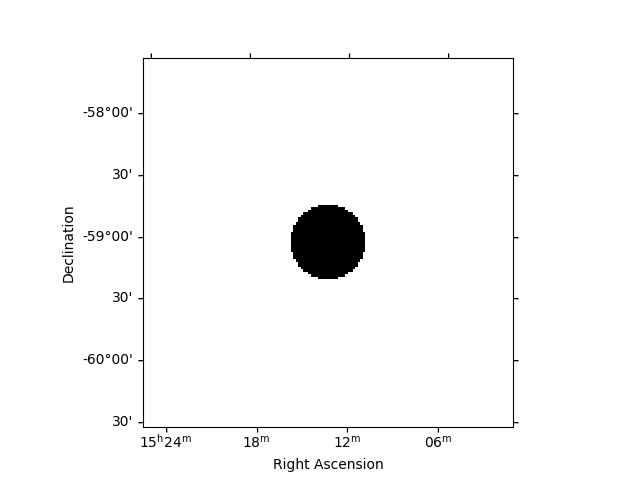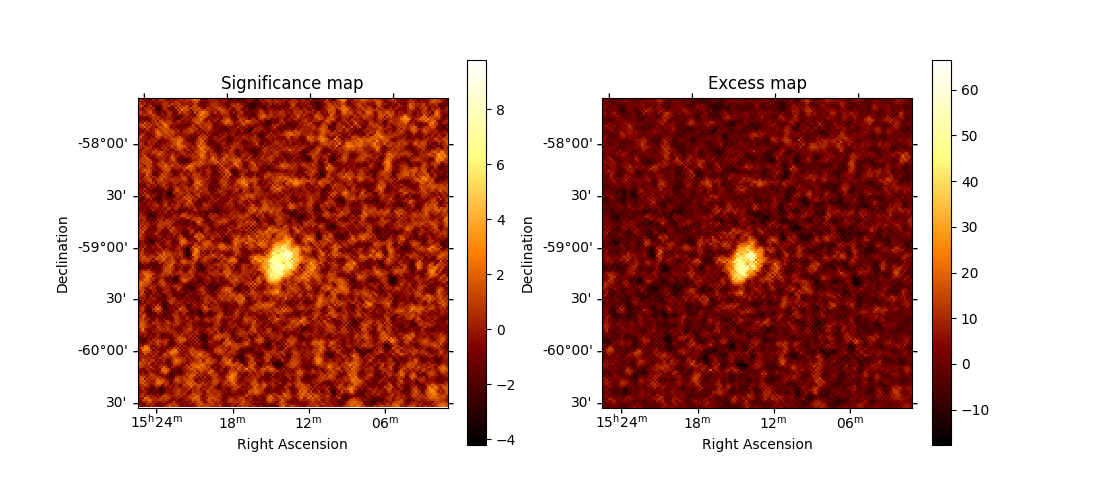Note
Go to the end to download the full example code or to run this example in your browser via Binder
Ring background map#
Create an excess (gamma-ray events) and a significance map extracting a ring background.
Context#
One of the challenges of IACT analysis is accounting for the large residual hadronic emission. An excess map, assumed to be a map of only gamma-ray events, requires a good estimate of the background. However, in the absence of a solid template bkg model it is not possible to obtain reliable background model a priori. It was often found necessary in classical cherenkov astronomy to perform a local renormalization of the existing templates, usually with a ring kernel. This assumes that most of the events are background and requires to have an exclusion mask to remove regions with bright signal from the estimation. To read more about this method, see here.
Objective#
Create an excess (gamma-ray events) map of MSH 15-52 as well as a significance map to determine how solid the signal is.
Proposed approach#
The analysis workflow is roughly:
Compute the sky maps keeping each observation separately using the
AnalysisclassEstimate the background using the
RingBackgroundMakerCompute the correlated excess and significance maps using the
ExcessMapEstimator
The normalised background thus obtained can be used for general modelling and fitting.
Setup#
As usual, we’ll start with some general imports…
import logging
import numpy as np
from scipy.stats import norm
# %matplotlib inline
import astropy.units as u
from astropy.coordinates import SkyCoord
from regions import CircleSkyRegion
import matplotlib.pyplot as plt
from gammapy.analysis import Analysis, AnalysisConfig
from gammapy.datasets import MapDatasetOnOff
from gammapy.estimators import ExcessMapEstimator
from gammapy.makers import RingBackgroundMaker
log = logging.getLogger(__name__)
Check setup#
from gammapy.utils.check import check_tutorials_setup
check_tutorials_setup()
System:
python_executable : /home/runner/work/gammapy-docs/gammapy-docs/gammapy/.tox/build_docs/bin/python
python_version : 3.9.16
machine : x86_64
system : Linux
Gammapy package:
version : 1.1
path : /home/runner/work/gammapy-docs/gammapy-docs/gammapy/.tox/build_docs/lib/python3.9/site-packages/gammapy
Other packages:
numpy : 1.24.3
scipy : 1.10.1
astropy : 5.2.2
regions : 0.7
click : 8.1.3
yaml : 6.0
IPython : 8.14.0
jupyterlab : not installed
matplotlib : 3.7.1
pandas : not installed
healpy : 1.16.2
iminuit : 2.21.3
sherpa : 4.15.1
naima : 0.10.0
emcee : 3.1.4
corner : 2.2.2
ray : 2.5.0
Gammapy environment variables:
GAMMAPY_DATA : /home/runner/work/gammapy-docs/gammapy-docs/gammapy-datasets/1.1
Creating the config file#
Now, we create a config file for out analysis. You may load this from disc if you have a pre-defined config file.
In this example, we will use a few HESS runs on the pulsar wind nebula, MSH 1552
# source_pos = SkyCoord.from_name("MSH 15-52")
source_pos = SkyCoord(228.32, -59.08, unit="deg")
config = AnalysisConfig()
# Select observations - 2.5 degrees from the source position
config.observations.datastore = "$GAMMAPY_DATA/hess-dl3-dr1/"
config.observations.obs_cone = {
"frame": "icrs",
"lon": source_pos.ra,
"lat": source_pos.dec,
"radius": 2.5 * u.deg,
}
config.datasets.type = "3d"
config.datasets.geom.wcs.skydir = {
"lon": source_pos.ra,
"lat": source_pos.dec,
"frame": "icrs",
} # The WCS geometry - centered on MSH 15-52
config.datasets.geom.wcs.width = {"width": "3 deg", "height": "3 deg"}
config.datasets.geom.wcs.binsize = "0.02 deg"
# Cutout size (for the run-wise event selection)
config.datasets.geom.selection.offset_max = 3.5 * u.deg
# We now fix the energy axis for the counts map - (the reconstructed energy binning)
config.datasets.geom.axes.energy.min = "0.5 TeV"
config.datasets.geom.axes.energy.max = "5 TeV"
config.datasets.geom.axes.energy.nbins = 10
# We need to extract the ring for each observation separately, hence, no stacking at this stage
config.datasets.stack = False
print(config)
AnalysisConfig
general:
log: {level: info, filename: null, filemode: null, format: null, datefmt: null}
outdir: .
n_jobs: 1
datasets_file: null
models_file: null
observations:
datastore: $GAMMAPY_DATA/hess-dl3-dr1
obs_ids: []
obs_file: null
obs_cone: {frame: icrs, lon: 228.32 deg, lat: -59.08 deg, radius: 2.5 deg}
obs_time: {start: null, stop: null}
required_irf: [aeff, edisp, psf, bkg]
datasets:
type: 3d
stack: false
geom:
wcs:
skydir: {frame: icrs, lon: 228.32 deg, lat: -59.08 deg}
binsize: 0.02 deg
width: {width: 3.0 deg, height: 3.0 deg}
binsize_irf: 0.2 deg
selection: {offset_max: 3.5 deg}
axes:
energy: {min: 0.5 TeV, max: 5.0 TeV, nbins: 10}
energy_true: {min: 0.5 TeV, max: 20.0 TeV, nbins: 16}
map_selection: [counts, exposure, background, psf, edisp]
background:
method: null
exclusion: null
parameters: {}
safe_mask:
methods: [aeff-default]
parameters: {}
on_region: {frame: null, lon: null, lat: null, radius: null}
containment_correction: true
fit:
fit_range: {min: null, max: null}
flux_points:
energy: {min: null, max: null, nbins: null}
source: source
parameters: {selection_optional: all}
excess_map:
correlation_radius: 0.1 deg
parameters: {}
energy_edges: {min: null, max: null, nbins: null}
light_curve:
time_intervals: {start: null, stop: null}
energy_edges: {min: null, max: null, nbins: null}
source: source
parameters: {selection_optional: all}
Getting the reduced dataset#
We now use the config file to do the initial data reduction which will then be used for a ring extraction
create the config
analysis = Analysis(config)
# for this specific case,w e do not need fine bins in true energy
analysis.config.datasets.geom.axes.energy_true = (
analysis.config.datasets.geom.axes.energy
)
# `First get the required observations
analysis.get_observations()
print(analysis.config)
AnalysisConfig
general:
log: {level: INFO, filename: null, filemode: null, format: null, datefmt: null}
outdir: .
n_jobs: 1
datasets_file: null
models_file: null
observations:
datastore: $GAMMAPY_DATA/hess-dl3-dr1
obs_ids: []
obs_file: null
obs_cone: {frame: icrs, lon: 228.32 deg, lat: -59.08 deg, radius: 2.5 deg}
obs_time: {start: null, stop: null}
required_irf: [aeff, edisp, psf, bkg]
datasets:
type: 3d
stack: false
geom:
wcs:
skydir: {frame: icrs, lon: 228.32 deg, lat: -59.08 deg}
binsize: 0.02 deg
width: {width: 3.0 deg, height: 3.0 deg}
binsize_irf: 0.2 deg
selection: {offset_max: 3.5 deg}
axes:
energy: {min: 0.5 TeV, max: 5.0 TeV, nbins: 10}
energy_true: {min: 0.5 TeV, max: 5.0 TeV, nbins: 10}
map_selection: [counts, exposure, background, psf, edisp]
background:
method: null
exclusion: null
parameters: {}
safe_mask:
methods: [aeff-default]
parameters: {}
on_region: {frame: null, lon: null, lat: null, radius: null}
containment_correction: true
fit:
fit_range: {min: null, max: null}
flux_points:
energy: {min: null, max: null, nbins: null}
source: source
parameters: {selection_optional: all}
excess_map:
correlation_radius: 0.1 deg
parameters: {}
energy_edges: {min: null, max: null, nbins: null}
light_curve:
time_intervals: {start: null, stop: null}
energy_edges: {min: null, max: null, nbins: null}
source: source
parameters: {selection_optional: all}
Data extraction
Extracting the ring background#
Since the ring background is extracted from real off events, we need to
use the Wstat statistics in this case. For this, we will use the
MapDatasetOnOFF and the RingBackgroundMaker classes.
Create exclusion mask#
First, we need to create an exclusion mask on the known sources. In this
case, we need to mask only MSH 15-52 but this depends on the sources
present in our field of view.
# get the geom that we use
geom = analysis.datasets[0].counts.geom
energy_axis = analysis.datasets[0].counts.geom.axes["energy"]
geom_image = geom.to_image().to_cube([energy_axis.squash()])
# Make the exclusion mask
regions = CircleSkyRegion(center=source_pos, radius=0.3 * u.deg)
exclusion_mask = ~geom_image.region_mask([regions])
exclusion_mask.sum_over_axes().plot()
plt.show()

For the present analysis, we use a ring with an inner radius of 0.5 deg and width of 0.3 deg.
ring_maker = RingBackgroundMaker(
r_in="0.5 deg", width="0.3 deg", exclusion_mask=exclusion_mask
)
Create a stacked dataset#
Now, we extract the background for each dataset and then stack the maps together to create a single stacked map for further analysis
energy_axis_true = analysis.datasets[0].exposure.geom.axes["energy_true"]
stacked_on_off = MapDatasetOnOff.create(
geom=geom_image, energy_axis_true=energy_axis_true, name="stacked"
)
for dataset in analysis.datasets:
# Ring extracting makes sense only for 2D analysis
dataset_on_off = ring_maker.run(dataset.to_image())
stacked_on_off.stack(dataset_on_off)
This stacked_on_off has on and off counts and acceptance
maps which we will use in all further analysis. The acceptance and
acceptance_off maps are the system acceptance of gamma-ray like
events in the on and off regions respectively.
print(stacked_on_off)
MapDatasetOnOff
---------------
Name : stacked
Total counts : 40051
Total background counts : 39151.26
Total excess counts : 899.74
Predicted counts : 39151.62
Predicted background counts : 39151.62
Predicted excess counts : nan
Exposure min : 1.11e+09 m2 s
Exposure max : 1.30e+10 m2 s
Number of total bins : 22500
Number of fit bins : 22500
Fit statistic type : wstat
Fit statistic value (-2 log(L)) : 26392.57
Number of models : 0
Number of parameters : 0
Number of free parameters : 0
Total counts_off : 88113384
Acceptance : 22500
Acceptance off : 49447600

